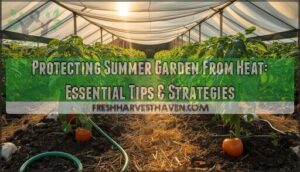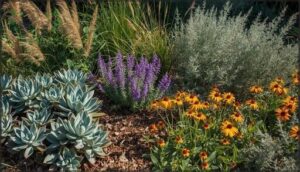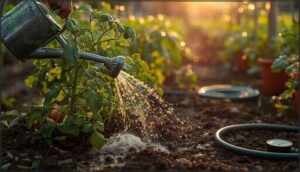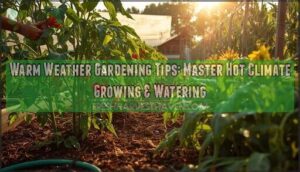This site is supported by our readers. We may earn a commission, at no cost to you, if you purchase through links.

Your tomatoes wilt by noon despite last night’s watering, pepper leaves curl into tight scrolls, and the lettuce you planted three weeks ago just bolted straight to seed. When temperatures push past 90°F, your garden doesn’t just slow down—it shifts into survival mode, shutting down the very processes that produce the harvest you’re counting on.
Heat stress costs home gardeners more crop loss than pests and diseases combined, yet most people don’t recognize the warning signs until their plants are already compromised. Protecting your summer garden from heat isn’t about babying delicate plants—it’s about understanding how high temperatures disrupt plant physiology and taking strategic action before stress becomes damage.
The difference between a garden that limps through summer and one that thrives comes down to timing, technique, and knowing which interventions deliver measurable results when the mercury climbs.
Table Of Contents
- Key Takeaways
- Understanding Heat Stress in Summer Gardens
- Choosing and Grouping Heat-Tolerant Plants
- Watering Strategies for Hot Weather
- Mulching and Soil Enhancement for Cooling
- Providing Shade and Physical Protection
- Frequently Asked Questions (FAQs)
- How do I protect my garden from extreme heat?
- What temperature is too hot for garden plants?
- How to protect your garden from extreme heat?
- How to keep plants alive in 100 degree weather?
- What temperature is too hot for a garden?
- How do container gardens differ in heat protection?
- When to harvest during extreme heat waves?
- Can companion planting reduce heat stress?
- Are automated irrigation systems worth installing?
- Do heat-stressed plants recover completely afterward?
- Conclusion
Key Takeaways
- Heat stress triggers your plants to shut down photosynthesis and close their stomata when temperatures exceed 85-95°F, causing more crop loss than pests and diseases combined—but you can counter this by watering deeply before 10 a.m., applying 5-7 cm of organic mulch to drop soil temperatures by 2-5°C, and installing 40-50% shade cloth mounted 1.5-2.5 meters above your beds.
- Your best defense is choosing the right plants from the start—native varieties show 86% higher survival under heat stress than non-natives, while drought-tolerant cultivars maintain 60% of standard yields with half the usual water, and strategic companion planting with tall species can lower afternoon leaf temperatures by 5-8°C.
- Drip irrigation systems slash water use by 30-50% while maintaining steady moisture 60-90 cm deep around root zones, and when paired with soil moisture sensors showing 60-70% field capacity, you’ll know exactly when to water instead of guessing—eliminating both drought stress and wasteful overwatering.
- Container gardens need extra attention because root zones heat 2-4°C hotter than ground beds, so you’ll need to group pots together for mutual shading, use reflective containers, water more frequently, and apply thick mulch layers to prevent the rapid moisture loss that kills containerized plants during heat waves.
Understanding Heat Stress in Summer Gardens
When temperatures soar, your garden doesn’t just feel uncomfortable—it faces real physiological challenges that can devastate your crops if you don’t recognize them early. Heat stress triggers a cascade of responses in plants, from slowed photosynthesis to cellular damage, and the effects vary depending on your specific growing conditions.
Let’s break down how extreme heat impacts your plants, what warning signs to watch for, and which factors make your garden especially vulnerable.
How High Temperatures Affect Plants
Heat stress disrupts plant physiology fundamentally. When leaf temperature climbs above 30–35°C, photosynthesis rates plummet as stomata close to conserve water, cutting CO2 intake and slowing growth.
Your plants can’t cool themselves efficiently during a heatwave, especially when soil health is poor or drought tolerance is low.
Temperature thresholds matter—sustained heat above 35°C triggers membrane damage and reduces yields, making heat stress management essential for summer success.
Signs of Heat Stress in Common Garden Crops
Your crops will show you when they’re struggling—you just need to recognize the warning signs. Watch for these telltale heat stress symptoms:
- Tomato leaves curl and yellow as temperatures spike 5–10°C above ambient, reducing fruit set markedly
- Pepper yields drop 20–40% when daytime crop temperature exceeds 32–35°C for extended periods
- Lettuce bolts prematurely above 25–30°C, cutting marketable heads by 30–60%
Regular garden monitoring helps you catch plant stress early and adjust your heat stress management approach before drought tolerance fails completely during a heatwave.
Factors That Increase Garden Heat Risk
Understanding what amplifies heat stress management challenges helps you protect vulnerable plants before damage occurs. Soil temperature above 49°C during heat waves accelerates moisture loss and root stress. High solar irradiance boosts transpiration rates, draining 15–25% of soil moisture daily. Containers heat faster than beds, intensifying plant stress. Combined humidity and climate extremes during a heatwave multiply disease pressure by 2–3x, threatening your entire garden ecosystem.
Effective garden management requires organizing information into main topic areas to address these challenges.
Choosing and Grouping Heat-Tolerant Plants
The smartest move you can make when heat threatens your garden is choosing plants that won’t just survive but actually thrive when temperatures climb. Instead of fighting nature, you’re working with it—selecting varieties bred or naturally adapted to handle intense sun and limited water.
Here’s how to build a heat-resilient garden from the ground up.
Selecting Drought-Resistant and Native Varieties
Native plant selection sets your garden up for long-term water efficiency. Native perennial species in arid regions show 86% higher survival under heat stress than non-natives, while drought-tolerant cultivars maintain 60% of standard yields under half the usual rainfall.
Your best picks include:
- Pollinator-friendly native forbs that cut irrigation needs by 30%
- Heat-resistant varieties bred specifically for extreme summers
- Drought-adapted mixes reducing supplemental watering by 20–40%.
Understanding key terms like AP study resources can also boost overall knowledge on various subjects.
Planting for Microclimate Resilience
A smart garden layout turns your beds into cool zones during heat waves. Grouping containers and drought-tolerant plants by microclimate exposure—south-facing, wind-prone, or sheltered spots—balances light and water use, improving heat tolerance by up to 25%.
Mixed plantings lower soil temperature by 4–6°C, while deep-rooted perennials access moisture that shallow annuals can’t reach. Plant diversity fosters ecosystem balance and climate resilience across your entire space.
Companion Planting for Heat Protection
Pairing tall, fast-growing species with heat-sensitive crops can drop afternoon leaf temperatures by 5–8°C, creating thermal buffering through companion planting. Plant guilds like legumes with brassicas improve soil temperature management and boost yield stability by up to 10%.
This microclimate creation strategy—a cornerstone of heat wave preparation—turns your garden into a resilient ecosystem ready for extreme weather.
Watering Strategies for Hot Weather
When temperatures soar, your watering routine becomes the lifeline your garden desperately needs. Getting water to your plants at the right time, in the right way, and in the right amounts can mean the difference between a thriving garden and one that’s barely hanging on.
Let’s walk through the key watering strategies that’ll keep your plants healthy and resilient through even the toughest heat waves.
Best Times to Water During Heat Waves
Water early in the morning—before 10 a.m. to cut evaporation by up to 40% and give your plants maximum uptake time. Morning watering also keeps soil temperature stable and promotes efficient water retention.
If you must water in the evening, finish before dusk to avoid prolonged leaf wetness and disease risk. Timing your irrigation systems this way sharpens water conservation while protecting soil moisture.
Deep Watering Techniques for Root Health
Roots chase moisture down, not up—that’s why watering deeply transforms your garden’s resilience. Deep irrigation systems push water 6–12 inches into the soil, building sturdy root networks that access moisture others can’t reach. Maintain soil moisture around 60–70% field capacity to keep roots thriving without drowning them.
Deep watering builds resilient root systems that reach moisture other plants can’t access during extreme heat
- Test soil depth with a trowel to confirm water penetration beyond surface layers
- Water slowly and thoroughly so soil absorbs moisture instead of shedding it as runoff
- Track root zone aeration by checking for drainage after deep soakings
Using Drip Irrigation and Efficient Watering Systems
Precision is your ally when summer heat peaks—drip irrigation delivers water exactly where roots need it. These efficient systems slash water use by 30–50% while maintaining steady soil moisture 60–90 cm deep around root zones. Emission rates of 2–4 liters per hour per emitter let you fine-tune allocation, and timer optimization can boost water conservation by 25–70%.
| System Component | Performance Metric | Heat Wave Benefit |
|---|---|---|
| Low-pressure emitters | 2–4 L/hour delivery | Sustains root zone moisture |
| Soil moisture sensors | 98% flow uniformity | Prevents over-watering stress |
| Timer optimization | 25–70% water savings | Maintains 60–90 cm penetration |
| Compounding filters | Consistent allocation | Stabilizes yield during heat |
| Drip line placement | Precise targeting | Reduces evaporation loss |
Monitoring Soil Moisture and Adjusting Schedules
Real-time moisture checks turn guesswork into control—capacitance-based soil moisture sensors give you 5–10% accuracy to schedule watering exactly when your beds need it.
Track these five fundamentals for water use efficiency:
- Set irrigation scheduling when moisture drops to 60–70% of field capacity
- Place sensors 4–6 inches deep for actionable root-zone data
- Apply 1–1.5 inches weekly during heat waves
- Log readings to spot drought patterns over the season
- Use mulch to stabilize soil temperature and cut daily loss by 10–15%
Mulching and Soil Enhancement for Cooling
When the sun beats down relentlessly, your soil becomes the frontline defense against heat damage. The right mulching approach creates a protective barrier that keeps roots cool and moisture locked in where plants need it most.
Let’s look at practical ways to fortify your soil and give your garden the cooling shield it needs to thrive through summer’s toughest days.
Types of Mulch for Heat Protection
Your mulch materials choice directly influences soil cooling and heat reduction in your garden. Organic mulch, like straw or wood chips, cuts daytime soil temperatures by 1.5–3.5°C compared to inorganic options.
For best performance, maintain a mulch depth of 5–7 cm—deep enough to moderate temperature without suffocating roots. White or reflective mulches can drop surface temperatures by 4–6°C under intense sun exposure.
Applying Mulch Effectively Around Plants
Spread mulch in a 5–7 cm layer around your plants, keeping it a few centimeters away from stems to prevent rot. This mulch depth lowers soil temperature and boosts water retention while organic matter decomposes, improving soil health and fertility over time.
The result? Stronger root growth and better conditions for heat-tolerant varieties to thrive all summer.
Boosting Soil Moisture Retention With Organic Amendments
Beyond mulching, you can boost your soil’s water-holding capacity with organic amendments. Mix compost or biochar into the top 15 cm before summer heat peaks—biochar boosts moisture retention by 20–40% in sandy soils, while compost raises organic matter and improves soil fertility over time.
These amendments work together with organic mulching to keep roots hydrated longer, strengthening soil health and supporting vigorous organic gardening practices.
Preventing Soil Overheating and Erosion
Extreme heat pushes soil temperature past safe thresholds—bare surfaces can spike 5°C hotter than the air, stressing roots and cutting germination by 25%.
A 5–10 cm mulch layer cools soil by 2–5°C and cuts evaporation up to 70%.
Add ground covers or biochar amendments to lock in water retention, boost soil fertility, and slash erosion risk by half when summer storms hit heat-stressed beds.
Providing Shade and Physical Protection
When your garden is baking in full sun, physical barriers become your best allies. Strategic shade structures and layout adjustments can drop temperatures by several degrees, giving your plants the relief they desperately need.
Here’s how to create protective zones that shield your garden from the worst of summer’s heat.
Installing Shade Cloths and Sunblock Nets
When temperatures spike, shade cloths become your garden’s first line of defense against scorching sun. These protective fabrics deliver measurable relief:
- Choose 40–50% shade density for vegetables—this balances cooling with adequate photosynthesis
- Mount covers 1.5–2.5 meters above plants to improve airflow and extend fabric life by 20–30%
- Select UV-stabilized sunblock materials that last 3–5 seasons
Install before heatwaves strike for maximum plant heat protection.
Creating Windbreaks and Sheltered Beds
With windbreak design, you can drop wind-driven heat by 40–60% and lower leaf temperatures by 1–2°C. Plant deciduous trees or shrubs 6–10 times their height from sheltered beds, choosing 40–60% porous barriers that balance airflow and shade cloth protection.
These windbreaks create cooler microclimates—ground temperatures in protected beds run 2–6°C lower during peak afternoon heat, giving your plants measurable relief.
Grouping Containers and Adjusting Garden Layout
With thoughtful Container Placement, you can craft cooler microclimates and shield roots from summer extremes. Try these Grouping Strategies for Garden Protection:
- Cluster containers for 2–4°C cooler interiors
- Pair deep-rooted perennials with shallow crops
- Use Spatial Arrangement to shade smaller pots
- Align irrigation for efficient Garden Maintenance
- Separate sun-loving and shade-tolerant plants for ideal Heatwave Preparation
Managing Airflow and Pruning for Heat Relief
When canopies trap hot air, you’re fighting nature instead of working with it. Strategic Pruning Techniques open up your garden’s respiratory system—Canopy Thinning by up to 25% can drop Leaf Temperature by 1–3°C during intense heat.
Remove crowded inner branches to boost Airflow Management and improve transpirational cooling.
This simple Heat Relief Strategy keeps photosynthesis humming when summer peaks, turning Heatwave Preparation into Summer Gardening Tips that deliver real results.
Frequently Asked Questions (FAQs)
How do I protect my garden from extreme heat?
You can safeguard your garden through strategic water conservation with drip irrigation, soil cooling using reflective mulches, and microclimate management by installing shade cloths—methods that reduce heat stress management challenges during intense heat waves.
What temperature is too hot for garden plants?
Here’s the thing: most garden plants hit the wall when daytime temperatures climb past 85–90°F for several days. Heat stress kicks in, triggering wilting, flower drop, and leaf scorch despite your best drought tolerance efforts.
How to protect your garden from extreme heat?
You’ll need a multi-layered approach to heat stress management for plants: use shade cloth for garden protection, apply mulch for soil cooling, water deeply to promote drought tolerance, and select heat-resilient varieties for lasting garden insulation.
How to keep plants alive in 100 degree weather?
Water deeply at dawn to reach roots 8–12 inches down, building drought survival by 15–25%.
Apply 2–4 inches of organic mulch to cut soil temperatures by up to 6°C, supporting thermal tolerance and heat resilience during extreme heat waves.
What temperature is too hot for a garden?
Most garden crops struggle once daytime highs exceed 90°F, with cool-season plants showing visible heat stress at 85–90°F.
Soil temperature, plant hardiness, and climate zones determine your garden’s heat tolerance thresholds during drought conditions and heat wave events.
How do container gardens differ in heat protection?
Container plants face faster heat buildup—root zones spike 2–4°C hotter than ground beds.
You’ll need frequent watering, reflective pots, strategic shading, and thick mulch layers to maintain soil temperature and boost heat resilience during any heat wave.
When to harvest during extreme heat waves?
The smartest heat wave harvesting happens before sunrise—when your tomatoes are cool, crisp, and full of moisture.
Extreme weather planning means timing summer crop management between 5:00 and 8:00 a.m., avoiding peak heat stress mitigation challenges entirely.
Can companion planting reduce heat stress?
Yes, companion planting reduces heat stress. Pairing tall, drought-tolerant plants with heat-sensitive crops creates shade and lowers leaf temperatures by 2–4°C, improving heat resilience and microclimate effects during heat waves.
Are automated irrigation systems worth installing?
Automated systems can slash water use by 38–62% using drip irrigation paired with soil sensors. Upfront costs run $300–$1,500, but you’ll see 10–25% lower bills and healthier plants during heat waves.
Do heat-stressed plants recover completely afterward?
Most heat-stressed plants show partial heat recovery, with leaf rebound within one to two weeks if soil moisture is restored.
However, stress resilience varies—severe heat waves may reduce long-term plant regeneration and photosynthetic capacity permanently.
Conclusion
Gardens lose up to 90% of their water through leaf transpiration when temperatures exceed 95°F—a staggering rate that explains why even well-watered plants collapse under extreme heat. Protecting your summer garden from heat isn’t a single fix; it’s a layered defense combining smart watering, strategic shade, and soil management.
Master these techniques now, and you’ll transform those brutal July afternoons from threats into just another day in a thriving, resilient garden that keeps producing despite the mercury.










